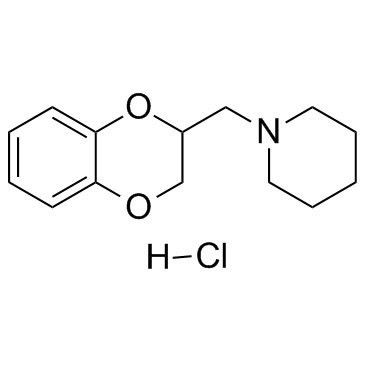Piperoxan hydrochloride (Benodaine hydrochloride) (Synonyms: DL-Piperoxan) |
| Katalog-Nr.GC31782 |
Piperoxan (Benodaine) Hydrochlorid ist ein ⋱2 Adrenozeptor-Antagonist.
Products are for research use only. Not for human use. We do not sell to patients.

Cas No.: 135-87-5
Sample solution is provided at 25 µL, 10mM.
Piperoxan hydrochloride is an α2 adrenoceptor antagonist.
When the medulla is superfused with α2 adrenoceptor antagonist Piperoxane (50 μM; 5 min) while the pons is with artificial cerebrospinal fluid (ACSF), the three inactive preparations display rhythmic phrenic bursts at a low frequency (2-4 c/min), and the phrenic burst frequency of the 12 active ones significantly increases during the last 3 min of Piperoxane applications (163±12% of the previous mean frequency). In active medullary preparations, the effects of NA applications (25 μM; 5 min) are compared when the preparations sre superfused either by ACSF (n=8) or by the α2 adrenoceptor antagonist Piperoxane (50 μM; PIP-ACSF; n=5). NA applications either alone (NA-ACSF) or with Piperoxane (PIP-ACSF+NA) significantly increases the phrenic burst frequency. However, the blockage of the medullary α2 adrenoceptors by Piperoxane potentiates a phrenic burst frequency increase: during the fifth minute of NA applications, the phrenic burst frequency reached 171±11% of the mean control value when ACSF is applied alone and 234±21% of the mean control value when PIP-ACSF is applied in control condition[1].
[1]. Viemari JC, et al. Nasal trigeminal inputs release the A5 inhibition received by the respiratory rhythm generator of the mouse neonate. J Neurophysiol. 2004 Feb;91(2):746-58. [2]. Bentley GA, et al. The antinociceptive action of some beta-adrenoceptor agonists in mice. Br J Pharmacol. 1986 Jul;88(3):515-21.
Average Rating: 5 (Based on Reviews and 13 reference(s) in Google Scholar.)
GLPBIO products are for RESEARCH USE ONLY. Please make sure your review or question is research based.
Required fields are marked with *




















